When a pristine Caribbean mangrove was decimated by a tourism project, locals on Union Island found a way to restore it to its former glory.
On a sweltering summer day in 1994, an ancient mangrove forest on Union Island was ripped apart.
A foreign investor had started the foundation work for a hotel, marina and golf course in Ashton lagoon on Union Island, one of the 32 Grenadine islands which dot the clear, blue waters of the southern Caribbean Sea.
The sounds of birds chirping and waves crashing against the intricately woven roots of the mangroves was replaced by the noise of excavators and cement trucks, cutting the trees to make way for culverts and concrete pillars.
Poorly-sized pillars collapsed, cutting off tidal flow in the 10-acre (4-hectare) lagoon. More mangrove trees began dying. The clear water turned putrid and yellow. And what was once the most ecologically diverse lagoon in the region became a barren eyesore and mosquito breeding ground.
Matthew Harvey, a local fisherman and campaigner, was 37 years old at the time and recalls watching the destruction. His home in the nearby coastal community of Ashton provides a panoramic, aerial view of the site. That view, which had brought him immense joy, began to leave him sad. The hurt was personal: for three years Harvey had protested the development. He knew it would destroy the mangroves and in turn, a fishery that provided the fishermen of Union Island and nearby islands with sea bass, herring, snapper, lobster, conch and shrimp.
Harvey had warned that giving investors rights to the mangroves could mean unprecedented ecological disaster for the island. But like similar projects in the Caribbean, promises of development and tourists were too alluring for a government eager to attract foreign investment and reduce unemployment.
“I tried, I protested,” Harvey told me as we stood outside his home in January 2020. “Mangroves are important to survival on Union.”
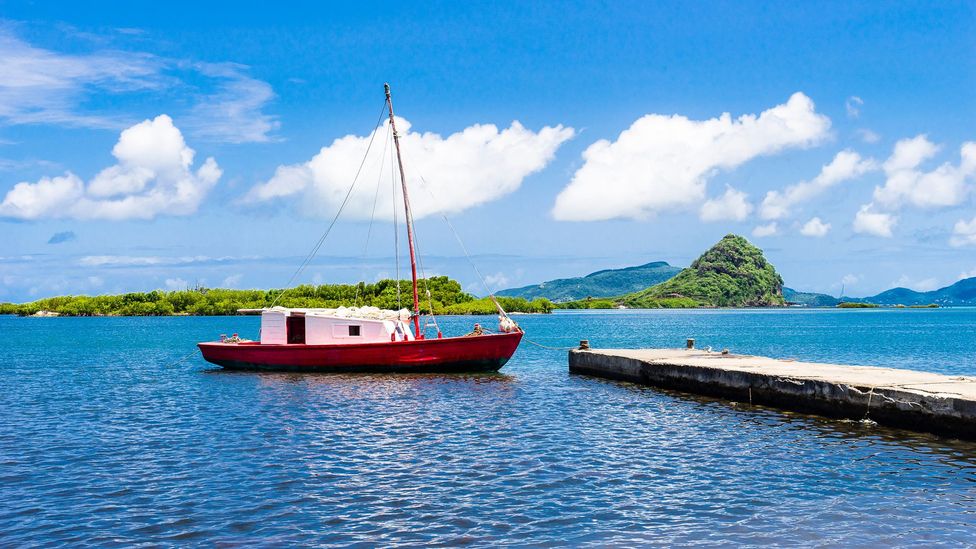
Less than a year after dredging began, the Valdetarro Construction Company declared bankruptcy. Grace Deagazio, who formerly worked for the company as a secretary and public relations officer, says an environmental impact assessment was carried out before works started.
“The assessment was done at the time for the mangroves and there was no problem with regards to the coral reefs,” she says. “There would have been no major environmental damage to the island itself, but our company went bankrupt due to an unfortunate series of financial problems. Union Island unfortunately got stuck right in the middle of the company’s bankruptcy; the project got frozen and it’s unfortunate.”
Future Planet also contacted members of the former leadership of the company but received no reply. The company declared bankruptcy in 1995.
Ashton Lagoon’s story is part of a sadly familiar wider picture. Despite their key role providing coastal protection, supporting local livelihoods and storing huge amounts of carbon, mangroves are disappearing, destroyed for coastal development. Globally, the area of mangroves decreased by over a million hectares (3,860 sq miles) between 1990 and 2020 – an area larger than the island of Puerto Rico. The economic fallout, including the loss of fisheries, has been calculated as greater than $40bn (£30bn) a year.
These forests of the sea are among the world’s most at-risk ecological systems and are being razed four times faster than terrestrial forests.
But Ashton Lagoon is not among those statistics, because its mangroves and fisheries are now thriving. The story of how that happened provides a blueprint for how other degraded mangroves around the world could one day be revived.
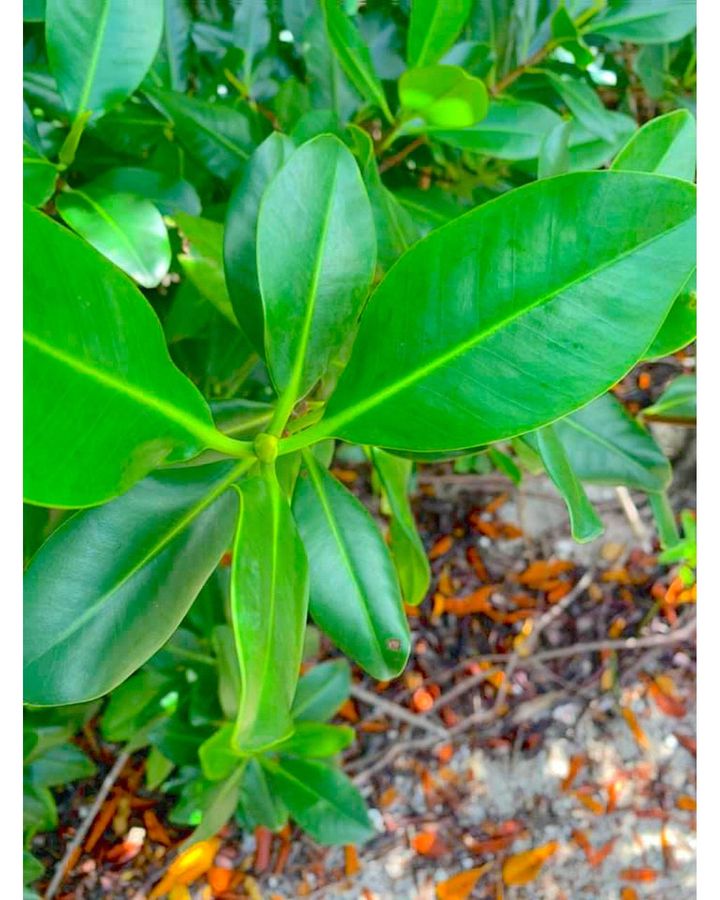
Mangroves live where most plants would die. Of the almost 400,000 plant species, only 1,500 are tolerant to saltwater. Some of these halophytes, as they are called, prevent salt from entering their roots, a process known as exclusion. Others excrete salt from special glands in their leaves.
Ashton Lagoon has three of the world’s 80 mangrove species: the red, which are excluders, and the black and white, which secrete salt. Today, the dark green, pointy leaves of black and red mangroves mingle with the round, light green leaves of the white to make a thick canopy. Its clear, emerald-green waters reveal submerged roots mooring the forest to the ocean floor.
Mangroves are essential to our livelihood, especially for us fishermen – Matthew Harvey
The area is a critical habitat for many species. Mangrove flowers attract birds like the egret, heron, bullfinch and hummingbird. Other birds, such as the brown pelican and the endangered West Indian whistling duck, use the forest for food and nesting. Fiddler and mangrove tree crabs scurry through the maze of roots, which also provide refuge to leatherback, hawksbill, loggerhead and the rare green turtles. Near the ocean floor, the ecosystem is home to large fish, like snappers and parrotfish, and juvenile fish, like the grouper, which can remain in the mangrove nursery for more than five years.
“Mangroves are essential to our livelihood, especially for us fishermen,” Harvey says. “Before the damage, there were nurseries for all marine life: conchs, lobster, fish, sharks. We fed our families and sold them to residents and businesses.”
Harvey, now 62 years old, is fit and slim, a man always on the go. His toughness and strength were key to what happened on Union Island after the tourism development failed.
In 1998, four years after the company declared bankruptcy, two Canadian researchers, Stephen Price and Purnima G Price, declared that Ashton Lagoon was “ecologically dead” in a report for the Union Island Association for Ecological Preservation. Mangrove forests are a notoriously difficult ecosystem to bring back once disturbed, they said, although damage to the lagoon system could be reversible “to some extent”.
In an effort to reverse the damage, Harvey, who was at the time president of the Union Island Eco Tourism Movement, teamed up with Orisha Joseph, director of local conservation agency SusGren, Lisa Sorenson, a conservation biologist and head of BirdsCaribbean, as well as officials of the Eastern Caribbean Coalition for Environmental Awareness.
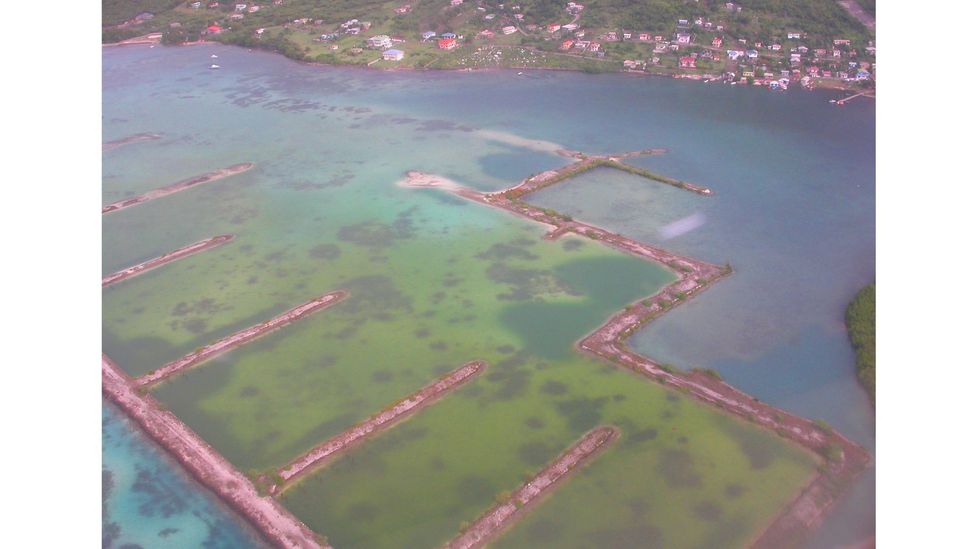
The trio knew that a scientist named Gregg Moore had also visited the lagoon in 1998 and conducted some tests, and they reached out to ask for his view.
Moore, a mangrove restoration ecologist at the University of New Hampshire, was surprised to hear from the team. It had been 10 years since his assessment of the lagoon. For many on Union Island, including Harvey, those years had been spent taking care of families and making ends meet, though the daily sight of the lagoon was never far from their minds.
It turned out that Moore’s assessment was indeed more optimistic than that of the Prices.
Moore told them that while the lagoon was severely damaged and the remaining trees were suffering from heat stress and extreme salinity, there was hope.
Mangroves are extremely resilient plants. They’re not delicate, but you have to have the right conditions for them – Gregg Moore
“Mangroves are extremely resilient plants,” says Moore. “They’re not delicate, but you have to have the right conditions for them. If you change the hydrology in the system dramatically, then you turn off their ability to self-regulate. Soil dumped during construction had blocked the tidal exchange and salt was no longer being flushed out and diluted.”
He told Harvey and Joseph that, at the very least, tidal flow needed to be re-established in the system. Doing this, however, would cost roughly $700,000 (£530,000), an amount the island could not afford. SusGren approached aid agencies for funding and started a community-based ecological restoration program. Harvey continued his environmental advocacy.
In May 2007, a workshop organised by Sorenson through Birds Caribbean brought the local community together to hear from coastal engineers, tourism consultants and scientists. Residents, fishers, teachers, environmentalists and the business community voiced their concerns, asked questions and made requests. Moore, who attended this first town hall, says that residents had the final say on how to proceed – a crucial aspect of community-based restoration.
In 2010, SusGren secured financing for the project, but it was quickly withdrawn because the government of St Vincent and the Grenadines had not granted permission for the restoration work. The go-ahead would come years later. For now, it looked as though, despite enormous community support, restoration was stalled. It had been 16 years since the mangroves had been decimated.
“We felt that if restoration works did not start soon, a new developer would come in,” says SusGren’s Joseph. “That fear is always there and we wanted to be the investor with the plan to protect the mangroves and provide opportunities for our people within them.”
Then in 2014, the Caribbean Community Climate Change Centre, the German Development Bank and the Philip Stevenson Foundation, which owns the neighbouring island of Petit St Vincent, came through with the $700,000 (£530,000). With funds and government permission now in place, work could begin.
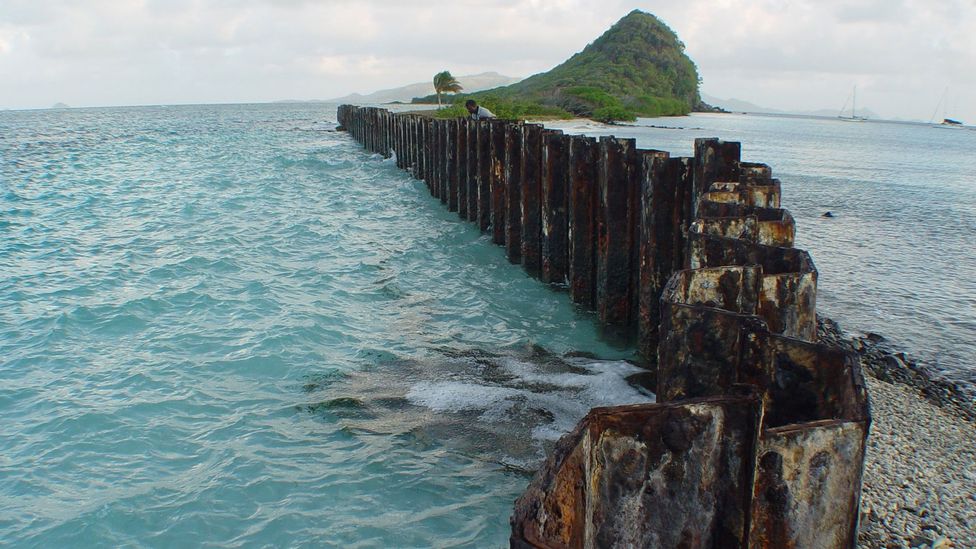
On the surface, restoration work might seem as simple as growing new mangrove plants and embedding them among existing trees. But the reality is far more complex.
Toward the end of 2017, excavators, trucks and bulldozers returned to Ashton Lagoon. But this time the machinery was there to undo the damage done a quarter of a century earlier. “We dug out the place, removed thousands of rusty galvanised sheet piles and pillars,” says Joseph.
Construction crews removed collapsed concrete culverts and excavated openings in the piers of the abandoned marina. Soon the tidal flow began to resemble what it had been in the past.
The next step was planting, led by Harvey. In 2018, he assembled a small team of four to replant the mangroves. Meshanda Laborde, a young woman from Union Island who is passionate about science, was among this group. The first step was to build a mangrove nursery using wood and coconut branches to regulate sunlight for the seedlings, she says.
“We then dug a small well near the shed to easily access water for the seedlings with the conditions closest to the environment we would eventually introduce them to.”
Restoration planting typically involves potting seedlings in small, black plastic bags (Harvey eschewed these bags and used bamboo stems from Grenada) in shallow water in a nursery before moving them back to the mangrove for planting. The seedlings were collected in the lagoon, carefully transported to the nursery for specialised care and root development, and returned to the mangrove when the planters believed they were strong enough to survive.
We had already cleared out the rotting and dead mangroves, so we took our plants into those areas and started setting them into the mud. We were knee-deep in mud but we didn’t mind – Meshanda Laborde
The team initially spent hours gathering as many “wildling” seedlings as they could find from mature mangroves. “We gathered 1,500 and 1,700 wildlings in the first two weeks,” says Laborde.
Casil Thomas, another member of the team, recalls collecting, setting and nursing the first batch of seedlings. “We had very early mornings, leaving before the Sun came up and we worked until it set. We pampered them and cared for them like our babies.”
Three months later, strong, healthy roots were jutting out of the bamboo stems – some of them over a foot (0.3m) long, says Laborde. They were ready for replanting, although the holders planned to give them protection for a further three years.
Carbon Count
The emissions from travel it took to report this story were 0kg CO2. The digital emissions from this story are an estimated 1.2g to 3.6g CO2 per page view. Find out more about how we calculated this figure here.
“We had already cleared out the rotting and dead mangroves, so we took our plants into those areas and started setting them into the mud,” says Laborde. “We were knee-deep in mud but we didn’t mind.”
Just as the team was experiencing some success, however, disaster hit the nursery. “There was a rat infestation,” says Harvey. “Rodents cut all the leaves and roots of the plants, to make nests.” Despite constant monitoring, they lost hundreds of the seedlings. The team spent two weeks inspecting every bamboo stem and its seedling for damage. They spread a mixture of cement and cornmeal between the rows of plants to get rid of the rodents.
To regain some of the lost time, Harvey experimented with a new method. “Instead of setting the seedlings in the shallow water where they take about six weeks to produce sufficient roots, we pushed them into the soil in the lagoon and within one week we got a good root system for planting,” he says. “I was happy because it worked and reduced the wait time.”
Laborde, who had studied human and social biology at school hoping to become a nurse, says she began to think of the seedlings as patients. “I learned so much, especially new planting techniques, even from the disappointments.”
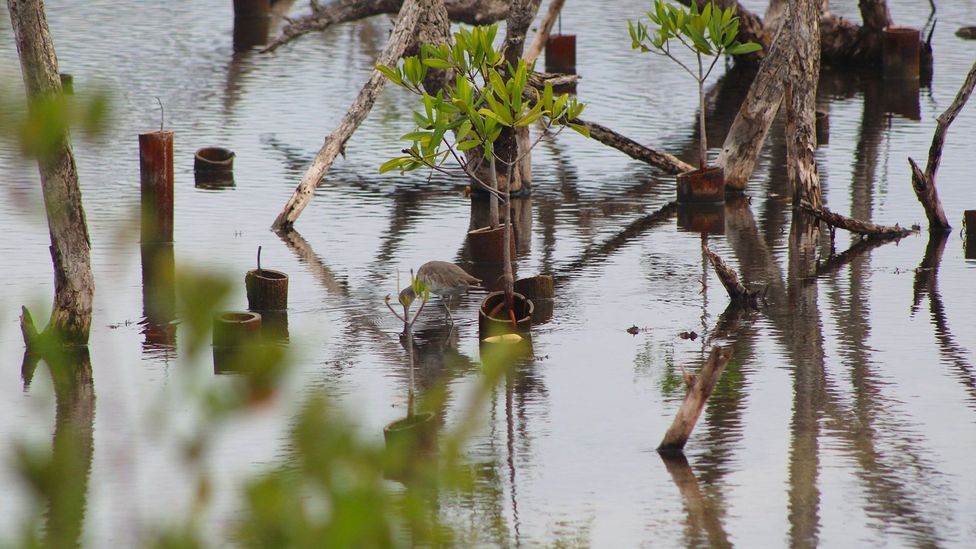
With increasing numbers of category 5 hurricanes, rising sea levels and fears of disappearing coastlines, restoration failure in Union Island could mean devastation not just of the fisheries, but of the entire island.
Union Island resident and educator Ann Harvey knows that well. In 2004, she opened a pre-school in memory of her son, Jamie, who had died suddenly the year before and had loved school and volunteering in social and environmental causes. The school was located less than 100m (328ft) from a small, bushy shrub of mangroves that had been spared from the excavator.
During the opening celebration, however, radio bulletins warned of an impending storm. As Harvey and her staff scrambled to place sandbags and board up the building, she worried that her new school would not stand a chance against raging wind and waves.
Within 24 hours, Hurricane Ivan, one of the most powerful hurricanes in a decade, bore down on the southern Caribbean. It destroyed 90% of the infrastructure on nearby Grenada.
The mangroves were taking the brunt of the storm, protecting the school. For hours, they swayed in the wind and big waves crashed into them – Ann Harvey
Harvey watched the waves from her house a few miles inland. “I stood in a corner, just staring, concerned that the [school] roof would be blown away,” she says. “But then I noticed something. The mangroves were taking the brunt of the storm, protecting the school. For hours, they swayed in the wind and big waves crashed into them. Some of them eventually broke away, but nothing happened to the school.”
Around the world, coastal structures like the pre-school are becoming increasingly vulnerable as climate change intensifies storms and sea-level rise means more water can rush inland. Coastal communities are particularly vulnerable to the impacts of warming ocean temperatures, sea-level rise, storms and flooding, according to a 2019 special report on oceans by the Intergovernmental Panel on Climate Change (IPCC).
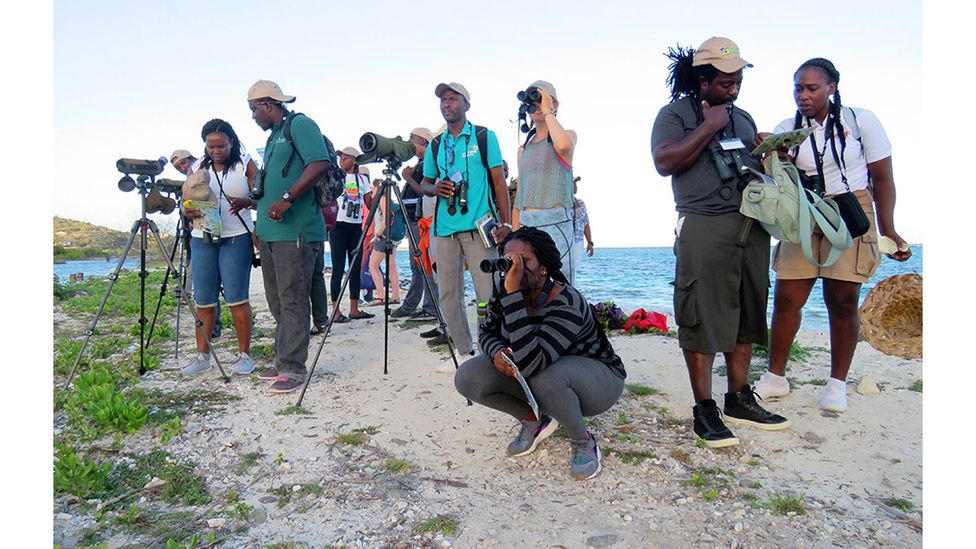
Shoring up marine ecosystems, like mangroves, is one of the pillars of building resilience, the IPCC said. With their thick foliage and gnarled, thick root systems, mangroves have been found to reduce wave height and energy. A 100m (328ft) buffer of mangroves can reduce wave height by up to 66%, one report found, and a 500m (1,640ft) buffer can reduce it as much as 99%.
This ability is critical to the future of many islands. “We have so many low-lying areas, some below sea level,” Matthew Harvey says. “If not for these mangroves, I am worried that people would not even be able to live here soon.”
Mangroves are also able to trap and store large amounts of carbon dioxide, an ability that has gained them increasing attention as an important component of climate mitigation.
But mangrove restoration has not always proven successful. Before the 1970s, mangroves were sometimes seen as a nuisance, but in 1984, the World Bank funded one of the first major restoration projects, providing a $26m (£20m) loan to plant just under 2,500 acres (1,000 hectares) of mangroves in the Philippines.
The government of the Philippines hoped that by replanting the mangroves, fish would return and the lives of over 90,000 residents improved. However, in 1995 researchers revealed that just 18% of the three million planted trees had survived. Researchers say the project failed to plant suitable species in appropriate sites.
Many other mangrove restoration projects have failed, including, more recently, a project in Sri Lanka to plant 3,000 acres (1,200 hectares) of mangrove after the 2004 tsunami. Less than 500 of those acres (202 hectares) have mangroves on them today – researchers attribute this to lack of attention to basic indicators for restoration such as selecting the right species, salinity and hydrology and the best sites. In a 2015 study of 160 marine coastal restoration projects over the previous 40 years, researchers found that half of the initiatives had failed.
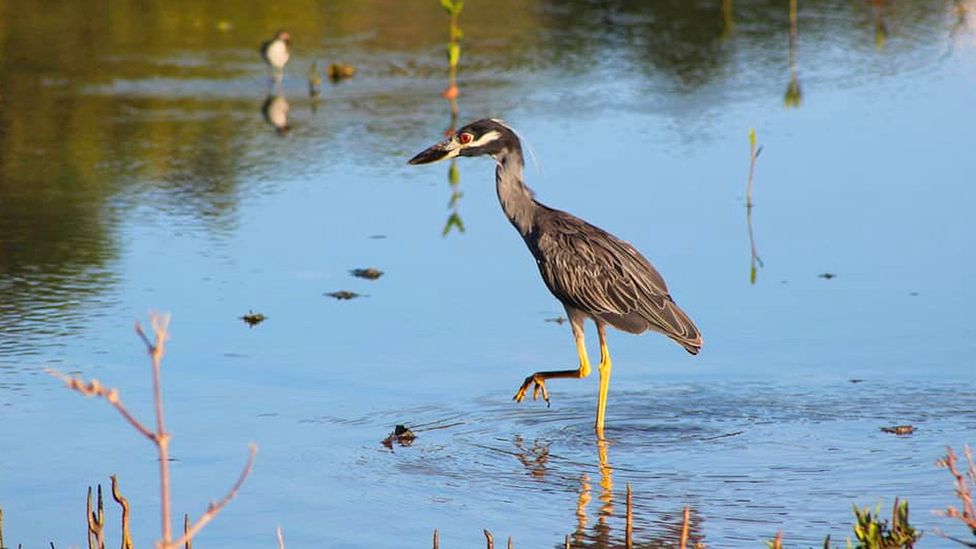
Ecologists like Moore say many of the projects are hampered by short-term thinking – they tend to focus on construction and ignore the community and the importance of long-term monitoring and stewardship.
“Most of the time the money spent on [coastal restoration] projects is for the engineering and the mobilisation and demobilisation of heavy equipment needed to prepare the site and obtain the right hydrology,” Moore says. “Then those trucks and bulldozers leave the site, construction crews take their final land survey, say ‘we got the grade right, the elevation right’, shake hands, pat each other on the back, and they’re done.”
I went into the schools and I got the students to understand the importance of mangroves, even before taking them to help restore them. Restoration requires a lot of hands and ongoing support and monitoring – Yvonne Edwin
Yvonne Edwin, a marine biologist from nearby St Lucia, agrees, but says the Caribbean is getting it right. Edwin was one of more than a dozen people who came together to restore a 10-acre belt of mangroves in St Lucia’s largest mangrove forest, the Makote Mangroves. She says the accomplishment would not have been possible without community involvement.
“I went into the schools and I got the students to understand the importance of mangroves, even before taking them to help restore them,” she says. “Restoration requires a lot of hands and ongoing support and monitoring. Over 400 students joined the community and partners in this venture.”
Edwin says mangrove restoration is already fraught with environmental challenges and projects cannot afford to be abandoned once the planting is over. This is especially the case in the Caribbean, which is sometimes faced with heavy rains post-planting.
Studies support Moore and Edwin’s view. The late ecologist Roy Lewis, one of the world’s first mangrove restoration experts, also warned against programmes that bring in community members to collect and plant seedlings but fail to retain them as stewards.
Union Island is trying learn these lessons and ensure stewardship is passed from one generation to another. SusGren has trained more than 50 young people in conservation and ecosystem monitoring, including former schoolteacher Kenya Ford. Her tasks included testing the salinity of the water in the mangrove, assessing tree growth and replanting trees to see where they grow best.
Such continued stewardship by residents will be integral to long-term success for the project, says Moore. “Successful mangrove projects care more than just ‘we planted a thousand trees and a thousand trees lived‘,” he says.
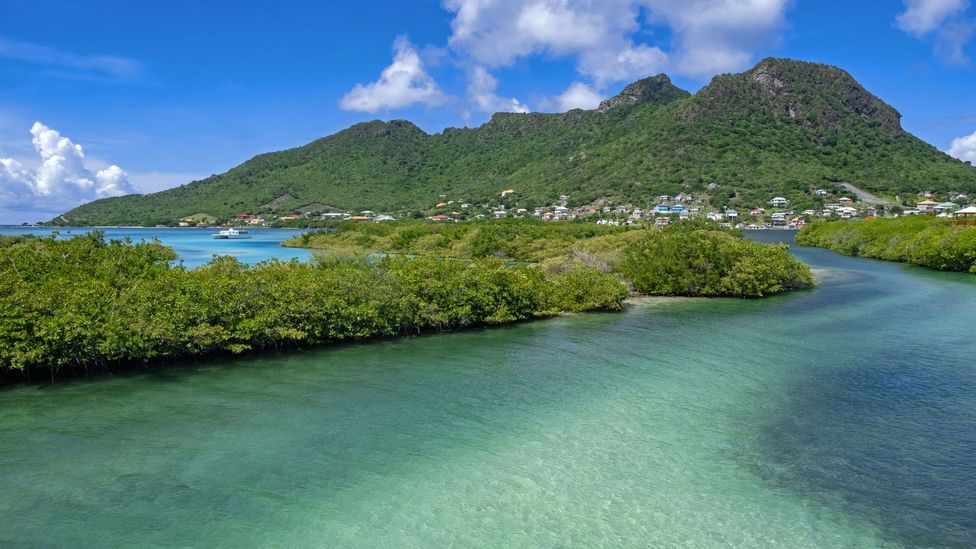
It is this approach to restoration which has helped the Caribbean become one of the few regions to increase mangrove cover in the last decade. SusGren and its partners now view Ashton Lagoon as fully restored, with over 90% of the mangroves planted in the lagoon still alive.
These 3,000 mangrove trees now stand about 5ft (1.5m) above sea level along 14 acres (6 hectares) of shoreline. Tidal flushing is back and the turquoise ocean water flows freely into the jade water of the mangrove twice daily. The fish and birds have returned.
Farmers now harvest sea moss from the lagoon – the raw seaweed is used to make ice cream and energy drinks popular in the Caribbean. With flowers in abundance in the mangroves again, bees have returned and beekeeping is thriving.
It’s better than a hotel. It’s not a case of a rich investor coming in and owning everything – Orisha Joseph
SusGren has constructed boardwalks and a pair of bridges across the lagoon, as well as bird towers and viewing decks. The once desolate area is now visited by tourists, academics and, for the first time in 25 years, locals, who have returned to enjoy the beauty and tranquility of the lagoon.
“It’s better than a hotel,” says Joseph. “It’s not a case of a rich investor coming in and owning everything.”
Harvey opened a neighbourhood bar in 2011 to supplement his struggling fishing income, and it is still open today. Now, though, he goes out to sea almost daily, sometimes spending up to 12 hours fishing. It’s hard work for a 62-year-old, but he plans to continue. As he sits on a small wooden bench at his bar and looks toward the lagoon, he runs his fingers through his full grey beard, saying: “It took us a long time, but our mangroves are back.”


